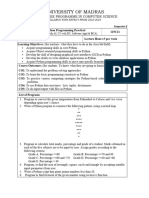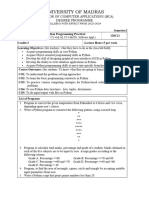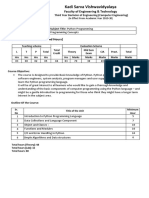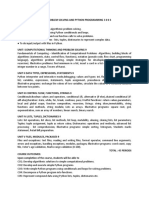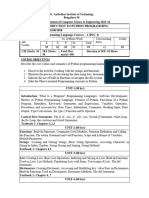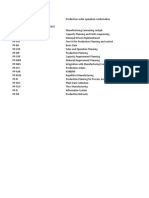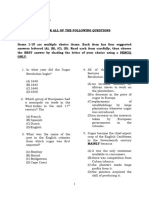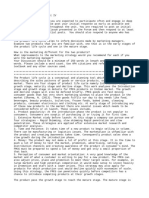N.M.S.S.
Vellaichamy Nadar College, Nagamalai, Madurai – 19
Title of the Course PYTHON PROGRAMMING
Part III
Year II Course
Category Core - 5 Credits 4 235603301
Semester III Code
Instructional Hours Lecture Tutorial
Lab Total CIA External Total
per week Practice
4 - -- 4 25 75 100
Learning Objectives
Describe the core syntax and semantics of Python programming language.
Discover the need for working with the strings and functions.
Illustrate the process of structuring the data using lists, dictionaries, tuples and sets.
Understand the usage of packages and Dictionaries
No. of
UNIT Details Periods for
the Unit
Introduction: The essence of computational problem solving
– Limits of computational problem solving-Computer algorithms-
Computer Hardware-Computer Software-The process of
I 12
computational problem solving-Python programming language -
Literals - Variables and Identifiers -Operators - Expressions and Data
types, Input / output.
Control Structures: Boolean Expressions - Selection Control - If
Statement- Indentation in Python- Multi-Way Selection -- Iterative
II Control- While Statement- Infinite loops- Definite vs. Indefinite 12
Loops- Boolean Flag. String, List and Dictionary, Manipulations
Building blocks of pythonprograms,Understandig and using ranges.
Functions: Program Routines- Defining Functions- More on
Functions: Calling Value-Returning Functions- Calling Non- Value-
III Returning Functions- Parameter Passing - Keyword Arguments in 12
Python - Default Arguments in Python-Variable Scope. Recursion:
Recursive Functions
Objects and their use: Software Objects - Turtle Graphics – Turtle
attributes-Modular Design: Modules - Top-Down Design - Python
Modules - Text Files: Opening, reading and writing text files –
IV Database Programming: Connecting to a database, Creating Tables, 12
INSERT, UPDATE, DELETE and READ operations, Transaction
Control, Disconnecting from a database, String Processing - Exception
Handling
Dictionaries and Sets: Dictionary type in Python - Set Data type.
Object Oriented Programming using Python: Encapsulation -
V 12
Inheritance – Polymorphism. Python packages: Simple programs using
the built-in functions ofpackages matplotlib, numpy, pandas etc.
Course Outcomes
Course On completion of this course, students will;
Outcomes
CO1 Develop and execute simple Python programs
CO2 Write simple Python programs using conditionals and looping for solving problems
CO3 Decompose a Python program into functions
CO4 Represent compound data using Python lists, tuples, dictionaries etc.
CO5 Read and write data from/to files in Python programs
Text Books (Latest Editions)
Charles Dierbach, “Introduction to Computer Science using Python - A
1. computational Problem Solving Focus”, Wiley India Edition, 2015.
2. Wesley J. Chun, “Core Python Applications Programming”, 3rd Edition , Pearson
Education, 2016
26th ACM – Department of Computer Science (Data Science and Analytics)– 20.03.2024 Page 6
�N.M.S.S.Vellaichamy Nadar College, Nagamalai, Madurai – 19
References Books
(Latest editions, and the style as given below must be strictly adhered to)
Mark Lutz, “Learning Python Powerful Object Oriented Programming”, O‟reilly
1.
Media 2018, 5th Edition.
Timothy A. Budd, “Exploring Python”, Tata MCGraw Hill Education Private
2.
Limited 2011, 1 st Edition.
John Zelle, “Python Programming: An Introduction to Computer Science”,
3 Second edition, Course Technology Cengage Publications, 2013, ISBN 978-
1590282410.
Michel Dawson, “Python Programming for Absolute Beginers” , Third Edition,
4
Course Technology Cengage Publications, 2013, ISBN 978-1435455009.
Web Resources
1.https://onlinecourses.swayam2.ac.in/cec22_cs20/preview
2. https://www.w3schools.com/python
3.https://www.javapoint.com/python-tutorial
Mapping with Programme Outcomes:
PO 1 PO 2 PO 3 PO 4 PO 5 PO 6 PO 7 PO 8 PO 9
CO1 S S S S S S S M S
CO2 S S M S S S S S S
CO3 S S S S S M S S S
CO4 S S S S M S S S S
CO5 S S S S S M S S S
S – Strong, M – Medium , L - Low
CO/PO PSO 1 PSO 2 PSO 3 PSO 4 PSO 5
CO1 3 3 3 3 3
CO2 3 3 3 3 3
CO3 3 3 3 3 3
CO4 3 3 3 3 3
CO5 3 3 3 3 3
Weightage 15 15 15 15 15
Weighted percentage of 3 3 3 3 3
course contribution to Pos
26th ACM – Department of Computer Science (Data Science and Analytics)– 20.03.2024 Page 7
�N.M.S.S.Vellaichamy Nadar College, Nagamalai, Madurai – 19
Title of the Course PYTHON PROGRAMMING LAB
Part III
Year II Course
Category Core 6 Credits 4 235603302
Semester III Code
Lab Total
Instructional Hours Lecture Tutorial
Practice
CIA External Total
per week - - 6 6 25 75 100
Learning Objectives
Acquire programming skills in core Python.
Acquire Object-oriented programming skills in Python.
Develop the skill of designing graphical-user interfaces (GUI) in Python.
Develop the ability to write database applications in Python.
Acquire Python programming skills to move into specific branches.
UNIT List of Experiment
1. Program to convert the given temperature from Fahrenheitto Celsius and vice versa
depending upon user‟s choice.
2. Program to calculate total marks, percentage and grade of
a student. Marks obtained in each of the five subjects are to be input by user. Assign
grades according to the following criteria:
Grade A: Percentage >=80 Grade B:Percentage >=70 and 80
Grade C: Percentage >=60 and <70 Grade D:Percentage >=40 and <60
Grade E: Percentage < 40
3. Program, to find the area of rectangle, square, circle and triangle by accepting suitable
input parameters from user.
4. Write a Python script that prints prime numbers less than20.
5. Program to find factorial of the given number usingrecursive function.
6. Write a Python program to count the number of even and odd numbers from array of N
numbers.
7. Write a Python class to reverse a string word by word.
8. Given a tuple and a list as input, write a program to count the occurrences of all items of
the list in the tuple. (Input :tuple = ('a', 'a', 'c', 'b', 'd'), list = ['a', 'b'], Output : 3)
9. Create a Savings Account class that behaves just like a BankAccount, but also has an
interest rate and a method that increases the balance by the appropriate amount of
interest (Hint:use Inheritance).
10. Write a Python program to construct the followingpattern, using a nested loop
*
**
***
****
*****
****
***
**
*
11. Read a file content and copy only the contents at odd lines into a new file.
12. Create a Turtle graphics window with specific size.
13. Write a Python program for Towers of Hanoi using recursion
14. Create a menu driven Python program with a dictionary for words and their meanings.
Devise a Python program to implement the HangmanGame.
26th ACM – Department of Computer Science (Data Science and Analytics)– 20.03.2024 Page 8
�N.M.S.S.Vellaichamy Nadar College, Nagamalai, Madurai – 19
Course Outcomes
Course On completion of this course, students will;
Outcomes
CO1 To understand the problem solving approaches
CO2 To learn the basic programming constructs in Python
To practice various computing strategies for Python-based solutions to real world
CO3
problems
CO4 To use Python data structures - lists, tuples, dictionaries.
CO5 To do input/output with files in Python.
Text Books (Latest Editions)
Charles Dierbach, “Introduction to Computer Science using Python - A
1. computational Problem Solving Focus”, Wiley India Edition, 2015.
2. Wesley J. Chun, “Core Python Applications Programming”, 3rd Edition , Pearson
Education, 2016
References Books
(Latest editions, and the style as given below must be strictly adhered to)
Mark Lutz, “Learning Python Powerful Object Oriented Programming”, O‟reilly
1.
Media 2018, 5th Edition.
Timothy A. Budd, “Exploring Python”, Tata MCGraw Hill Education Private
2.
Limited 2011, 1 st Edition.
John Zelle, “Python Programming: An Introduction to Computer Science”,
3 Second edition, Course Technology Cengage Publications, 2013, ISBN 978-
1590282410.
Michel Dawson, “Python Programming for Absolute Beginers” , Third Edition,
4
Course Technology Cengage Publications, 2013, ISBN 978-1435455009.
Web Resources
1.https://onlinecourses.swayam2.ac.in/cec22_cs20/preview
2. https://www.w3schools.com/python
3.https://www.javapoint.com/python-tutorial
26th ACM – Department of Computer Science (Data Science and Analytics)– 20.03.2024 Page 9
�N.M.S.S.Vellaichamy Nadar College, Nagamalai, Madurai – 19
Title of the Course PHP PROGRAMMING LAB
Part IV
Year II Course
Category SEC – 4 Credits 1
Code 234403356
Semester III
Instructional Hours Lecture Tutorial
Lab Total CIA External Total
per week Practice
- - 1 1 25 75 100
Learning Objectives
The objective of this course is to teach the fundamentals of quantum information
processing, including quantum computation, quantum cryptography, and quantum
information theory.
Contents
1. Simple PHP programs using expressions andoperators.
2. Programs to demonstrate the usage of controlstructures
3. Programs using Looping structures
4. Programs using arrays
5. Programs using string functions
6. Simple and parameterized functions.
7. To process personal details using File
8. To design an student mark database using HTML Formand process using PHP
9. Programs using OOPS concepts
10. Program to design a web page using various formcontrols
11. Data validation in web pages.
12. Using cookies and session variables
13. Database Connectivity
Course Outcomes
Course On completion of this course, students will;
Outcomes
CO1 Use PHP in-built functions and string functions.
CO2 Assessment of using files
CO3 Practice passing of parameters from HTML to PHP
CO4 Audit the usage of COOKIES and SESSIONS.
CO5 Design web pages for personal and business applications
References Books
(Latest editions, and the style as given below must be strictly adhered to)
1 Paul Deitel, Harvey Deitel, & Abbey Deitel. (2018). Internet and World Wide
Web –How to Program, 5 th Edition. India: Pearson India Education.
Web Resources
1. https://www.w3schools.com/php/
2 https://www.javatpoint.com/php-tutorial
26th ACM – Department of Computer Science (Data Science and Analytics)– 20.03.2024 Page 10









